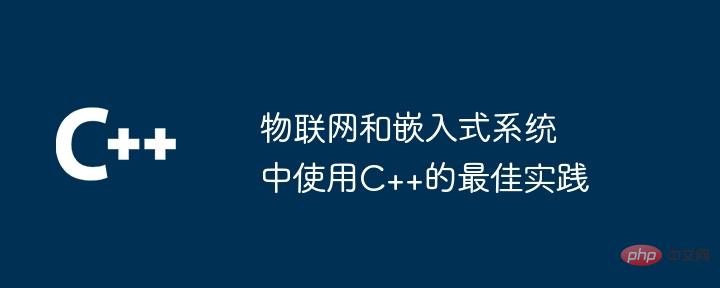Home >Backend Development >C++ >Best practices for using C++ in IoT and embedded systems
Best practices for using C++ in IoT and embedded systems
- WBOYWBOYWBOYWBOYWBOYWBOYWBOYWBOYWBOYWBOYWBOYWBOYWBOriginal
- 2024-06-02 09:39:571116browse

Best Practices for Using C++ in IoT and Embedded Systems
Introduction
C++ is a powerful language that is widely used in IoT and embedded systems. However, using C++ in these restricted environments requires following specific best practices to ensure performance and reliability.
Memory Management
- Use smart pointers: Smart pointers automatically manage memory to avoid memory leaks and dangling pointers.
- Consider using a memory pool: Memory pools provide a more efficient way to allocate and free memory than standard malloc()/free().
- Minimize memory allocation: In embedded systems, memory resources are limited. Reducing memory allocation can improve performance.
Threads and multitasking
- Use RAII principle: RAII (resource acquisition is initialization) ensures that during the object life cycle Release resources, including threads, when finished.
- Synchronous access to shared resources: Use synchronization mechanisms such as mutexes and semaphores to ensure the integrity of data when accessing shared resources at the same time.
- Beware of deadlocks: In a multi-threaded environment, avoid creating situations that may lead to deadlocks.
Real-time
- Use non-blocking I/O: In a real-time system, blocking I/O will cause Unpredictable delays. With non-blocking I/O, a program can continue executing while waiting for data.
- Optimize interrupt handling: Minimize the code path in the interrupt handler to reduce interrupt latency.
- Use timer: Use timer to achieve precise timing and task scheduling.
Power management
- Reduce object creation: Creating and destroying objects requires energy. Minimize unnecessary object creation.
- Use static allocation: When possible, use static allocation instead of dynamic allocation because it requires less energy.
- Consider using low-power mode: Put the processor into low-power mode when not in use.
Code organization
- Keep the code modular:Organize the code into manageable modules to improve maintainability performance and debugging.
- Documented API: Clearly document APIs and functions so others can easily understand and use them.
- Use version control: Use a version control system to track code changes and collaborate on development.
Practical case:
Consider the following example implementation of an IoT device that uses C++ to manage LED status:
#include <Arduino.h>
// LED 引脚号
const int ledPin = 13;
// LED 状态
bool ledState = false;
void setup() {
// 设置 LED 引脚为输出
pinMode(ledPin, OUTPUT);
}
void loop() {
// 改变 LED 状态
ledState = !ledState;
// 根据 LED 状态设置 LED 引脚
digitalWrite(ledPin, ledState);
// 延迟一段时间
delay(500);
}This example shows Understands the basic principles of using C++ to manage IoT devices, including the use of smart pointers and thread safety technology.
Follow these best practices to ensure efficient and reliable use of C++ in IoT and embedded systems.
The above is the detailed content of Best practices for using C++ in IoT and embedded systems. For more information, please follow other related articles on the PHP Chinese website!

